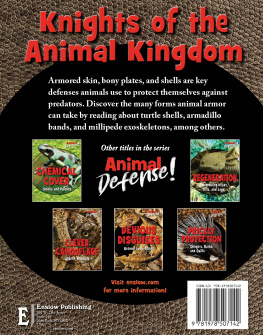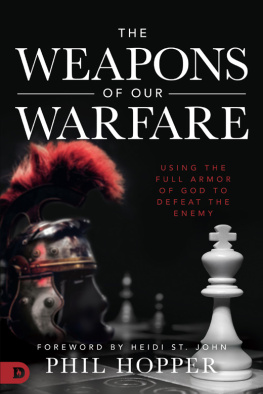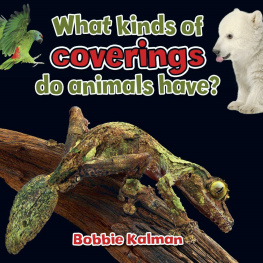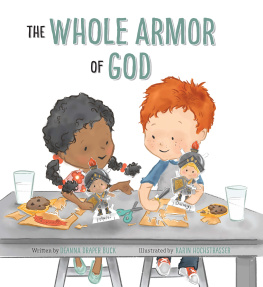
These books are dedicated to Emily, who inspired the author.
Susan K. Mitchell
Published in 2020 by Enslow Publishing, LLC.
101 W. 23rd Street, Suite 240, New York, NY 10011
Copyright 2020 by Enslow Publishing, LLC.
All rights reserved.
No part of this book may be reproduced by any means without the written permission of the publisher.
Library of Congress Cataloging-in-Publication Data
Names: Berne, Emma Carlson, author. | Mitchell, Susan K., author.
Title: Armor up : exoskeletons, scales, and shells / Emma Carlson Berne and Susan K. Mitchell.
Description: New York: Enslow Publishing, 2020. | Series: Animal defense! | Audience: Grade 3-6. | Includes bibliographical references and index.
Identifiers: LCCN 2018046709| ISBN 9781978507142 (library bound) | ISBN 9781978508071 (paperback)
Subjects: LCSH: Armored animalsJuvenile literature. | Animal defenses Juvenile literature.
Classification: LCC QL940 .B47 2020 | DDC 591.47/7dc23
LC record available at https://lccn.loc.gov/2018046709
Printed in the United States of America
To Our Readers: We have done our best to make sure all website addresses in this book were active and appropriate when we went to press. However, the author and the publisher have no control over and assume no liability for the material available on those websites or on any websites they may link to. Any comments or suggestions can be sent by email to customerservice@enslow.com.
Portions of this book originally appeared in Animals with Awesome Armor: Shells, Scales, and Exoskeletons.
Photo Credits: Cover, p..
Contents
Introduction
W hen people think of the word armor, they probably picture a knight from the Middle Ages wearing chain mail and a big metal helmet. Or maybe they imagine a modern soldier wearing a bulletproof vest and a helmet covered in .
One thing they probably dont imagine is an armadillo. They probably arent thinking of a clam or even a snail. But these animals all wear armor, just like knights did and soldiers still do. Instead of putting on their armor before a battle, these animals wear their armor all the time. Its a part of their bodies. Shells, scales, bony plates, and tough skin help reptiles; . Their entire bodies are armor! The exoskeleton is like wearing bones on the outside of the body. A hard covering surrounds the soft inside of the body.
Just like knights going into battle, animals use armor to protect themselves from harm, especially from predators. Armadillos have heavy bands of armor across their backs and sides. When a bird of prey swoops down to try to grab an armadillo, the birds talons cant grab the armor bands. The armor makes the armadillo too heavy and awkward to grab. The bird might fly away. Armor for the win!
Even small animals can have unusually tough armor. The scaly-foot snail lives on the bottom of the Indian Ocean. This little snail has to defend itself against crabs. It has evolved a special three-layer shell that is hard for crabs to crack when they squeeze it with their claws. The scaly-foot snail even has armor on its foot. Scales help protect the delicate foot against other snails that are venomous.
help the jaguar bite through armor to kill prey such as turtles, armadillos, and caimans, which are relatives of the alligator.

The heavily armored alligator snapping turtle can be found in lakes, swamps, and large rivers in the southeastern United States.
Armor helps protect animals against more than just predators. Shells, scales, and tough skin shield animals from extreme heat, provide shade, and even protect against insect stings or bites. Armored animals have an extra layer of protection in an often fierce, dangerous world. They can live another day to eat instead of being eaten.
Chapter 1
Armor of All Sorts
A ll animal armor is tough, but it is not all the same. Some armor is bone. Some is a substance called . Some of these materials are very thick and rigid. Some are flexible. Some animals grow several coverings of armor in their lifetimes. Others have permanent armor.
Bone is one of the toughest types of armor. Bones are strong enough to make up the skeleton inside humans and many animals. They can also be a tough covering on the outside. Bony armor is usually connected to the outside of an animals skin. That means that the animal cannot crawl out of its armor. Turtles are one type of animal with this kind of
The great thing about bony armor is that it lasts forever. An animal with armor made of bone never has to grow new armor. Bone armor grows with the animal. But even tough bony armor has weaknesses. For example, bone has nerve endings. This means that an animal with bony armor can feel pressure and pain if the armor is damaged.

Tortoises are relatives of turtles that live only on land. Turtles live partly in water and partly on land. Tortoises, like turtles, have bony armor.
Not Chain Mail: Armor Materials
Bony armor is often covered in keratin. That is the same type of material that makes up human fingernails. Keratin by itself is also a kind of armor. It grows like bony armor, but it is much softer than bone. It bends easily. Many reptiles, such as snakes, have tough scales made of keratin.
Many insects and crabs have exoskeletons made of chitin. It is very strong, but unlike bone, it does not grow. Animals with chitin armor have to keep growing new armor. As the animal grows, its old armor splits and the animal sheds it. This is called molting. Underneath is a new suit of chitin armor ready to protect the animal.

Vets use drills, screws, wire, and glue to hold together broken turtle shells until they heal.
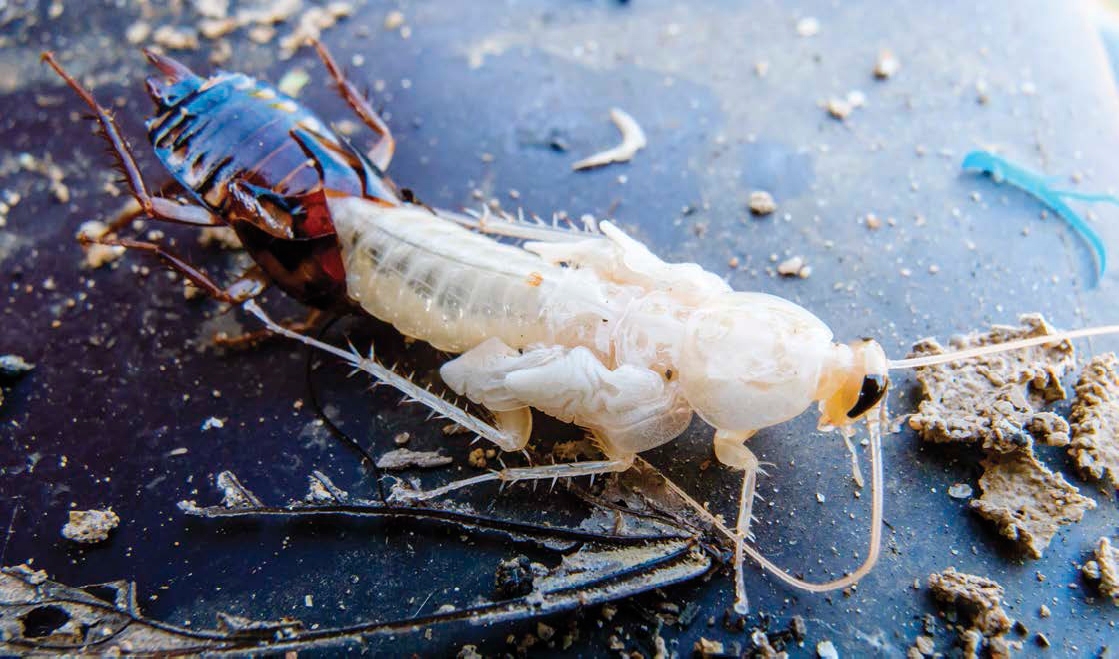
A cockroach molts, shedding its old exoskeleton to reveal a new one underneath.
Some animal armor also contains calcium carbonate. This is a mineral found in shelled sea animals and snails. An animal with this type of armor grows its own shell. Its body makes the calcium carbonate, which forms a shell around the animal. This makes the armor harder, stiffer, and stronger than armor made only from chitin. Animals with this type of armor do not have to molt. They just keep adding calcium to their shell.
Dinosaur Armor
Some of the most well-known rough and tough armored animals were the dinosaurs. But just because they were big did not mean they were always safe. Plant-eating dinosaurs were especially at risk. They could be huge but usually did not have sharp claws or teeth for defense. Instead, they had hard, bony plates or super-thick skin for protection.
Ancient Armor
In 2011, a miner in Canada accidentally dug up what later turned out to be dinosaur fossils. He had found the fossilized remains of half of the whole body, including armor, skin, and tendons. The dinosaur was a heavily armored type known as a nodosaur. The nodosaur was covered with thorny armored plates from head to tail and had a pair of horns jutting out of its shoulders.
Next page
